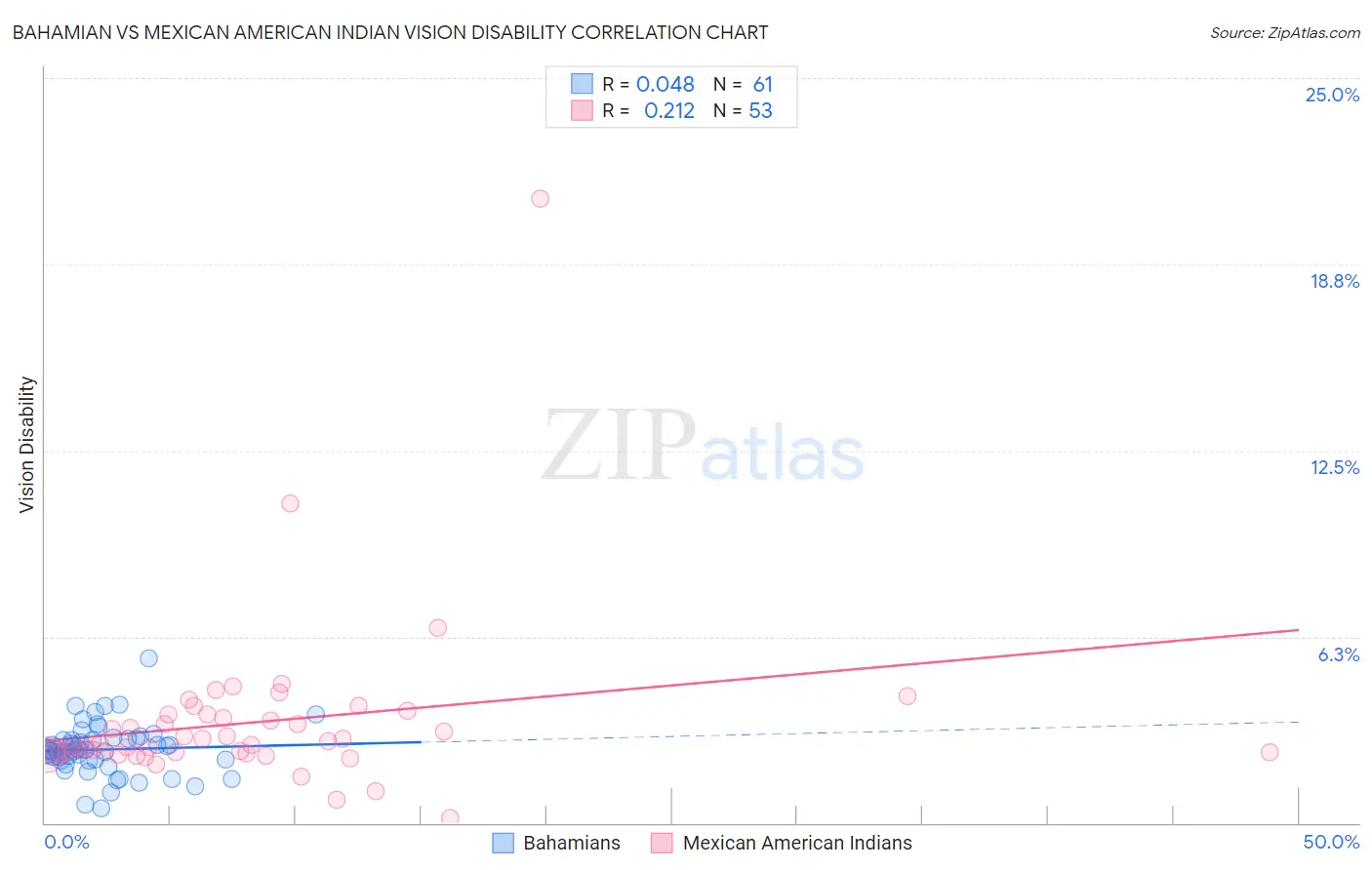Bahamian vs Mexican American Indian Vision Disability
COMPARE
Bahamian
Mexican American Indian
Vision Disability
Vision Disability Comparison
Bahamians
Mexican American Indians
2.4%
VISION DISABILITY
0.0/ 100
METRIC RATING
277th/ 347
METRIC RANK
2.4%
VISION DISABILITY
0.1/ 100
METRIC RATING
266th/ 347
METRIC RANK
Bahamian vs Mexican American Indian Vision Disability Correlation Chart
The statistical analysis conducted on geographies consisting of 112,669,490 people shows no correlation between the proportion of Bahamians and percentage of population with vision disability in the United States with a correlation coefficient (R) of 0.048 and weighted average of 2.4%. Similarly, the statistical analysis conducted on geographies consisting of 317,438,641 people shows a weak positive correlation between the proportion of Mexican American Indians and percentage of population with vision disability in the United States with a correlation coefficient (R) of 0.212 and weighted average of 2.4%, a difference of 1.7%.

Vision Disability Correlation Summary
| Measurement | Bahamian | Mexican American Indian |
| Minimum | 0.51% | 0.16% |
| Maximum | 5.5% | 20.9% |
| Range | 5.0% | 20.8% |
| Mean | 2.5% | 3.4% |
| Median | 2.4% | 2.7% |
| Interquartile 25% (IQ1) | 2.1% | 2.4% |
| Interquartile 75% (IQ3) | 2.8% | 3.6% |
| Interquartile Range (IQR) | 0.69% | 1.3% |
| Standard Deviation (Sample) | 0.83% | 2.9% |
| Standard Deviation (Population) | 0.83% | 2.8% |
Demographics Similar to Bahamians and Mexican American Indians by Vision Disability
In terms of vision disability, the demographic groups most similar to Bahamians are Scotch-Irish (2.4%, a difference of 0.040%), Chippewa (2.4%, a difference of 0.13%), Spanish (2.4%, a difference of 0.16%), Nepalese (2.4%, a difference of 0.17%), and Cape Verdean (2.4%, a difference of 0.21%). Similarly, the demographic groups most similar to Mexican American Indians are Ute (2.4%, a difference of 0.010%), Immigrants from Jamaica (2.4%, a difference of 0.040%), Immigrants from Liberia (2.4%, a difference of 0.070%), Senegalese (2.4%, a difference of 0.10%), and Immigrants from Belize (2.4%, a difference of 0.19%).
| Demographics | Rating | Rank | Vision Disability |
| Fijians | 0.1 /100 | #261 | Tragic 2.4% |
| Jamaicans | 0.1 /100 | #262 | Tragic 2.4% |
| Immigrants | Belize | 0.1 /100 | #263 | Tragic 2.4% |
| Immigrants | Liberia | 0.1 /100 | #264 | Tragic 2.4% |
| Immigrants | Jamaica | 0.1 /100 | #265 | Tragic 2.4% |
| Mexican American Indians | 0.1 /100 | #266 | Tragic 2.4% |
| Ute | 0.1 /100 | #267 | Tragic 2.4% |
| Senegalese | 0.1 /100 | #268 | Tragic 2.4% |
| Celtics | 0.1 /100 | #269 | Tragic 2.4% |
| Cubans | 0.1 /100 | #270 | Tragic 2.4% |
| Immigrants | Azores | 0.1 /100 | #271 | Tragic 2.4% |
| Spaniards | 0.1 /100 | #272 | Tragic 2.4% |
| Immigrants | Bahamas | 0.1 /100 | #273 | Tragic 2.4% |
| Immigrants | Latin America | 0.0 /100 | #274 | Tragic 2.4% |
| Chippewa | 0.0 /100 | #275 | Tragic 2.4% |
| Scotch-Irish | 0.0 /100 | #276 | Tragic 2.4% |
| Bahamians | 0.0 /100 | #277 | Tragic 2.4% |
| Spanish | 0.0 /100 | #278 | Tragic 2.4% |
| Nepalese | 0.0 /100 | #279 | Tragic 2.4% |
| Cape Verdeans | 0.0 /100 | #280 | Tragic 2.4% |
| U.S. Virgin Islanders | 0.0 /100 | #281 | Tragic 2.5% |